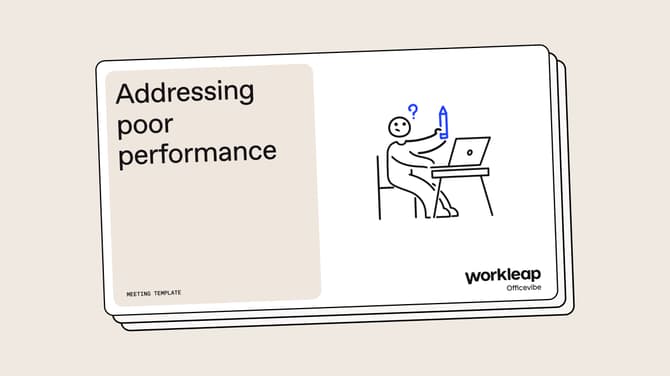Goal setting plays an important role in everything from employee engagement to team alignment to retention. Setting goals not only helps individuals and teams alike reach their full potential but also helps with employee motivation toward big picture, organizational goals.
All goals are fit for purpose. But what types of goals should be set in different contexts? From professional development goals to employee performance goals, we’ve outlined some of the best practices when it comes to goal setting.
Exclusive online summit
·
May 23 2024
Moments that matter: how to seed great work
What's in this article
- What are good professional development goals for employees?
- How to align employee performance goals with organizational objectives
- Goal-setting frameworks to help reach business objectives
- 10 Empowering employee goal-setting examples
- How to set employee goals that drive results
- Best practices for supporting employee performance goals
- Tools and techniques to track employee goal progress
- Individual and organizational success: The benefits of well-defined goals
What are good professional development goals for employees?
You’ll need to work with a variety of individual goal types to ensure your employees can achieve their potential, including:
- Performance goals
- Personal development goals
- Collaboration goals
- Time management goals
- Innovation goals
Aligning employee performance objectives with organizational goals is crucial for creating a unified sense of purpose within a team and achieving long-term success for both the individuals and the organization.
Officevibe' goals and OKR tool enables employees to align and connect individual performance goals to organizational objectives, ensuring strong alignment across the company.
Performance goals
Employee performance goals are an essential component of any business plan. They are the short-term performance objectives that employees must achieve to meet specific business goals or job responsibilities. For instance, a sales representative might have a quarterly sales quota they need to hit, or a marketing manager may be tasked with landing a new client. These goals serve as a benchmark for performance evaluation and help employees focus on achieving measurable results.
Some examples of performance goals include increasing sales revenue by a certain percentage, reducing customer complaints by a specific number, or increasing the number of successful product launches within a set timeframe.
Personal development goals
Personal development goals are focused on growth and learning and contribute to business objectives in a more indirect way. They are geared toward helping employees acquire new skills, knowledge, and abilities that can be used to improve their performance and participate in the success of the organization.
For example, an employee may want to improve their communication skills by taking a public speaking course, or they may want to earn an advanced degree to improve their expertise in a particular field.
Personal development goals are often self-driven, and employees may seek guidance and support from their managers to achieve them. These goals are not always tied to specific performance metrics, but they can help employees develop a growth mindset, increase their job satisfaction, and enhance their value to the organization.
Team collaboration and relationship building goals
These goals focus on improving team dynamics, communication, and trust. By setting team collaboration and relationship building goals, managers can help team members work together more effectively, which can lead to improved productivity, higher job satisfaction, and a more positive work environment.
Examples of team collaboration and relationship building goals may include enhancing communication and trust among team members, improving group dynamics and teamwork, and fostering a positive and productive work environment.
Time management goals
Effective time management is crucial to achieving business goals and staying competitive. Setting time management goals can help employees prioritize tasks, allocate resources effectively, and streamline processes, which can lead to increased productivity and better results.
Time management goals may include prioritizing tasks and allocating resources effectively, streamlining processes to reduce wasted time, and ensuring tasks are completed within set deadlines.
Innovation and creativity goals
Innovation and creativity are essential to driving growth and staying ahead of the competition. Setting innovation and creativity goals can help employees develop new ideas, products, or processes that contribute to business success.
By fostering a culture of innovation and risk-taking, managers can encourage employees to take on new challenges and think outside the box.
Examples of innovation and creativity goals may include encouraging the development of new ideas or processes, fostering a culture of innovation and risk-taking, and staying ahead of the competition with cutting-edge products.
How to align employee performance goals with organizational objectives
Aligning employee performance goals with organizational objectives is critical to ensure both employees and the organization are heading in the same direction. Here are three ways to achieve this alignment:
- Clear communication and expectation-setting: Managers should communicate the organization's objectives, mission, and values to employees to align their individual goals with the bigger picture, boost motivation, and clarify expectations.
- Link individual goals to organizational objectives: Managers should break down organizational objectives into smaller, measurable tasks and assign them to employees as specific goals tied to organizational goals. By linking individual goals to broader objectives, employees see the direct impact of their work on the company's success, motivating them to perform better.
- Provide ongoing support and feedback: Managers should regularly review employee progress, offer guidance, and adjust goals as needed to keep them aligned with evolving organizational objectives. This will foster a sense of shared responsibility and commitment. Regular feedback will also help employees understand what they need to do to improve their performance.
Try our helpful ways to foster strong team alignment within your business and rally your teams around shared, motivating goals.
Goal-setting frameworks to help reach business objectives
SMART goal setting
SMART goal setting helps employees grow and develop professionally so they can better contribute to business objectives. The SMART acronym stands for Specific, Measurable, Attainable, Relevant, and Time-based. These elements help create structure and clarity for employees to achieve their targets. Let's take a closer look at each element:
- Specific: For employees to hit their goals, they need to know precisely what they’re working toward. A vague goal is difficult to achieve, and without clear direction, employees may lose motivation. Instead, make sure your employees’ goals are specific and concrete.
- Measurable: Measuring progress keeps employees motivated and moving toward their goals. So, it’s important to set clear key performance indicators (KPIs) and have reliable benchmarks. The right software or tools can help you track and measure progress toward your measurable goals.
- Attainable: Goals should be aspirational but not so aspirational that they’re unrealistic. If employees feel their goals are impossible to achieve, they may become disheartened and unmotivated. Ensure your employees’ goals are achievable and aligned with their skills, experience, and resources.
- Relevant: Goals need to feel relevant to the business context and your team member’s professional aspirations. Align employees’ personal motivators with team goals by setting objectives that help them grow professionally while contributing to the organization’s overall success.
- Time-based: Setting a timeframe for achieving goals helps employees stay on track, break goals down into smaller action items, and tick off milestones along the way.
OKR goal setting
OKR stands for Objectives and Key Results. This goal-setting framework is designed to help organizations align their objectives with measurable results. Its primary use is to track performance at every level (organizational, departmental, team, and individual) while making sure the entire team is aligned on what performance means and how to get there.
Objectives are specific and measurable goals, while key results measure progress toward achieving them. OKRs break down large goals into smaller, manageable objectives, with key results that are easily trackable.
Clear understanding of an organization's mission and strategy is important, and goals should be set regularly, on a quarterly basis. The framework is useful for prioritizing results-oriented goals, aligning individual goals with the organization's strategy.
There’s no one-size-fits-all when it comes to goal-setting frameworks. However, by using one of them (or a combination) to set employee performance goals, your team is sure to hit their targets every time, while staying aligned with the organization’s objectives.
10 Empowering employee goal-setting examples
Find below realistic workplace scenarios to inspire you for your next goal-setting session. Each employee goal-setting example is outlined with how they meet the SMART goal criteria or the OKR framework standard, depending on the scenario.
Examples of employee performance goals
Objective: I will improve our website user experience by the end of the year.
- Key result 1: I will achieve a 15% increase in website traffic.
- Key result 2: I will reduce the bounce rate by 20%.
- Key result 3: I will increase MQLs coming from website forms by 30%.
Objective: I will develop our brand's social media strategy for the next quarter.
- Key result 1: I will post 4 social media posts per week.
- Key result 2: I will increase our follower base from 7,000 to 10,000.
- Key result 3: I will maintain our engagement rate of 3%.
Examples of personal development goals for employees
This week, I will reach out to one co-worker with a role I aspire to. From there, I’ll schedule a one-on-one meeting to learn more about their role within the company and how they contribute to the team and company’s success.
- Specific: The employee needs to reach out to a co-worker to discuss their role in the company.
- Measurable: They need to schedule a one-on-one meeting.
- Achievable: The employee only has to schedule a single meeting, which is very doable given the time frame.
- Relevant: The co-worker has a role the employee hopes to one day grow into, making the conversation relevant to their professional development.
- Time-based: The employee must reach out and schedule the meeting by the end of the week.
This quarter, I will schedule one hour every Friday afternoon to read a book on communication styles. When I read, I’ll take notes on how to be a more assertive communicator at work.
- Specific: The employee needs to read about and take notes on how to be a more assertive communicator at work.
- Measurable: They need to read and take notes at a certain time (and for a certain time period) each week.
- Achievable: Reading and taking notes one hour each week is a realistic goal, especially because the employee can tackle it during work hours.
- Relevant: Learning more about communication styles sets the employee up for success and fosters better communication with the team.
- Time-based: The employee will continue pursuing the goal for the entire quarter.
Examples of team collaboration and relationship-building goals
This month, I will participate in team-building activities like Lunch & Learn sessions and coffee chats with my team members. The more I foster bonds, the better the trust and work dynamics.
- Specific: The employee will participate in team-building moments this month.
- Measurable: They will attend at least one Lunch & Learn session and have coffee chats with two team members each week this month.
- Achievable: It only requires a few hours of the employee's time each week to participate in the team-building activities scheduled by the company.
- Relevant: Fostering bonds leads to a more productive and engaged team.
- Time-based: The employee will pursue this goal for the entire month.
Feedback helps me improve my own performance. To be added value for my peers, I will actively engage in open communication and provide constructive feedback to help them.
- Specific: The employee will engage in open communication and provide constructive feedback to their peers.
- Measurable: The employee will aim to provide at least one piece of constructive feedback per week to a team member.
- Achievable: They will take 15 minutes at the end of the week to write down and share feedback.
- Relevant: Providing feedback to colleagues fosters a culture of continuous improvement within the team and develops communication skills.
- Time-based: The employee will continue pursuing the goal on an ongoing basis.
Examples of time management goals
In order to prioritize my tasks and allocate time effectively, I will develop and follow a daily schedule to meet my deadlines better.
- Specific: The employee will develop and follow a daily schedule to meet deadlines.
- Measurable: They will track progress and assess whether they're completing tasks on time and meeting deadlines more consistently.
- Achievable: The employee will use tools such as digital calendars or time management apps.
- Relevant: Self-management is necessary for employee productivity and performance.
- Time-based: The employee will develop and follow a daily schedule for the next month to see how it impacts their ability to prioritize tasks and meet deadlines.
Ahead of my annual performance review, I'll identify and implement tactics to streamline workflows and reduce time spent on non-essential tasks so I can focus on achieving the goals set out for me.
- Specific: The employee will implement tactics to prioritize tasks and manage their time effectively to meet deadlines.
- Measurable: They will track their progress by ensuring they are able to complete all the tasks associated with achieving their goals.
- Achievable: Developing and following tactics is achievable as it allows the employee to break down tasks into smaller, manageable parts.
- Relevant: Prioritizing tasks and reducing time spent on non-essential tasks is crucial for personal and professional success.
- Time-based: The employee will implement this goal immediately and continue to use it as an ongoing strategy for managing their workload.
Examples of innovation and creativity goals
Staying in the know of new industry trends and best practices will inspire me in my own work, so I've planned on attending a training workshop and conference every month.
- Specific: The employee will attend one training workshop and conference each month to learn about new industry trends and best practices.
- Measurable: They will attend one training workshop and conference each month.
- Achievable: Attending one workshop and conference each month is feasible and can be planned for.
- Relevant: Staying up-to-date on new industry trends and best practices will provide inspiration and help improve work performance.
- Time-based: Attending one workshop and conference will be achieved each month.
At this upcoming quarterly performance review, I'll make sure to contribute at least one innovative idea or solution to improve some of our current products or processes.
- Specific: The employee will contribute at least one innovative idea or solution to improve some of the current products or processes.
- Measurable: They will contribute at least one innovative idea or solution at their quarterly performance review.
- Achievable: The employee can easily start their brainstorming process ahead of time and does not need to spend more than an hour developing their idea.
- Relevant: Brainstorming and sharing innovative ideas and solutions to improve products and processes can increase internal efficiency and productivity, and drive business growth.
- Time-based: The employee will have provided at least one innovative idea or solution at their quarterly performance review.
We know that defining meaningful goals for your employees can be a challenge, so we've outlined these 9 tips for setting employee goals to help you along the way.
How to set employee goals that drive results
Goal setting is an important process that helps employees stay motivated, focused, and productive. To set effective goals, consider our 3 simple steps:
Step 1: Schedule one-on-one meetings
Setting goals is something you can tackle with every member of your team in a one-on-one meeting. When you book your employees, let them know ahead of time that you want to set individual goals with them that align with the team goals. That way, they can arrive at the meeting prepared with some ideas for how they can develop, and where they most see themselves contributing.
Step 2: Use a goal-setting software like Officevibe to make it easier
Officevibe's performance management software not only allows you to work with individual employees to set goals but also enables you to set goals for your entire team, promoting transparency throughout the goal-setting process.
This transparent approach helps team members understand how their contributions align with the company's objectives, thereby enhancing employee engagement, motivation, and team alignment.
Step 3: Create SMART employee goals and OKRs
You can work with your team members to create SMART employee development goals and define appropriate OKRs that tie back to company objectives. Then, set smaller action items, monitor progress, and offer feedback in every one-on-one to ensure all goals are aligned with the bigger picture.
Officevibe keeps a clear record of how every employee achieved their goals, making your next performance reviews a breeze.
Best practices for supporting employee performance goals
Clear communication, regular feedback, goal assessment and review, and recognition are crucial to support employee performance goals.
It's the basis for a virtuous cycle, as improving employee performance not only leads to higher job satisfaction, engagement, motivation, and morale, but also contributes to an organization's overall productivity, efficiency, and bottom line.
Communication and transparency:
- Schedule weekly team meetings to discuss project updates and address any concerns. For example, use video conferences or chat platforms to keep remote team members connected.
- Encourage open-door policy, allowing employees to approach managers with questions or suggestions. For instance, set up regular office hours or virtual drop-in sessions.
Regular performance reviews and feedback:
- Conduct quarterly performance review meetings to assess progress and provide feedback. For example, use a structured evaluation form and discuss it face-to-face with the employee.
- Offer real-time feedback for significant accomplishments or areas of improvement. For instance, give praise or constructive criticism during meetings or via email.
Goal adjustment:
- Revisit employee goals during performance reviews to ensure they are still relevant and achievable. For example, modify goals in response to changes in job responsibilities or market conditions.
- Encourage employees to take ownership of their goals and make adjustments as needed. For instance, support them in identifying new opportunities or challenges that may require goal revision.
Recognition and reward for achievements:
- Implement an employee recognition program to celebrate outstanding performances. For example, encourage employees to recognize their peers when they are given a helpful hand or when a team member produces tremendous work.
- Offer tangible rewards for reaching significant milestones or achieving goals. For instance, provide career development opportunities or targeted mentorship programs.
Tools and techniques to track employee goal progress
Project management software
Project management software enables teams to organize, track, and collaborate on projects, ensuring timely completion within budget. It enables teams to set timelines, assign tasks, track progress, and manage resources effectively, making it crucial for achieving performance goals.
Project management software examples (you may already be using!) are Asana, Trello, and Monday.com, which provide features such as task assignment, deadline tracking, progress updates, and collaboration tools.
Goal tracking software
Goal tracking software are digital tools that help individuals and teams track progress toward specific goals. It is important for tracking progress because it enables employees and teams to set measurable goals and adjust their efforts as needed.
Officevibe's OKRs and goal planning tool is an example of goal tracking software that uses the OKR framework. It allows teams to set goals tied to measurable key performance indicators (KPIs), and track progress. Features such as progress tracking, goal alignment, and regular check-ins help employees stay on track and achieve their goals.
Key takeaways
1. Aligning employee performance goals
One of the essential aspects of managing employee performance is to ensure that each team member's performance goals are aligned with the overall goals of the organization. When everyone is working toward the same goals, it creates a unified sense of purpose and direction for the team.
For instance, if the company's primary objective is to increase sales revenue, employee performance goals should be tailored to support this objective. This ensures that the team is working together in a coordinated and strategic way, leading to better outcomes for the business.
2. Fostering personal and professional development
Encouraging personal and professional development is crucial for ensuring long-term success for both individuals and the organization so they can grow together. Employees who are provided with opportunities to improve their skills, knowledge, and performance tend to be more engaged and productive. This, in turn, leads to increased innovation and career growth.
Investing in employee development can take many forms, such as offering training and development programs, providing mentoring or coaching, or giving employees the autonomy to work on projects that align with their career goals.
3. Enhancing employee motivation and engagement
Giving employees a clear understanding of their roles and responsibilities is an essential aspect of enhancing motivation and engagement. When employees understand how their contributions impact the company's success, they are more likely to feel invested in their work.
Additionally, providing employees with opportunities to give feedback and suggestions can increase engagement and motivation, as it shows that their opinions are valued. This can be achieved through regular team meetings, surveys, or suggestion boxes, among other methods.
Individual and organizational success: The benefits of well-defined goals
Goal setting is crucial for the long-term success of an organization. It helps create a motivated and focused workforce by setting well-defined and aligned goals that contribute to both individual and organizational performance.
Ultimately, creating alignment throughout an organization is key to ensuring everyone is working toward the same objectives, and goal setting is an essential tool in achieving this alignment.
Equip HR and managers with tools to engage, recognize, and drive performance.




